
Italian Seaside Splendor: A 10-Day Journey Through Naples & Sorrento
 10 Day Tour of Naples and Sorrento
10 Day Tour of Naples and Sorrento
Overview
Trip Map
Itinerary
Inclusions
Reviews







10 Days 9 Nights
Best Time: Jan-Dec
Nature Lovers
Exploring Scenic Countryside
Experience the charm and beauty of Italy's stunning coastline on this 10-day journey through Naples and Sorrento. Discover the rich history of Pompeii, hike the breathtaking Path of the Gods, and explore the enchanting Isle of Capri. Relax on Fornillo Beach, savor fresh seafood, and enjoy private guided tours that reveal hidden gems. Wander through historic coastal towns, visit the magnificent Villa Rufolo and Villa Cimbrone, and take in the panoramic views from the heights of Mount Vesuvius. With detailed travel guidance available through our mobile app, every moment of this adventure promises to be unforgettable.
- Wander through the historic streets and vibrant markets of Naples on a private guided walking tour.
- Experience the ancient wonders of the Roman Empire on a self-guided excursion to Pompeii.
- Enjoy a private Guided Hike of the Gods, renowned for its stunning views of the Amalfi Coast.
- Take in the stunning beauty of the coastline from the Villa Rufolo and Villa Cimbrone.
- Explore the picturesque Isle of Capri with its crystal-clear waters and dramatic cliffs.
Experience the charm and beauty of Italy's stunning coastline on this 10-day journey through Naples and Sorrento. Discover the rich history of Pompeii, hike the breathtaking Path of the Gods, and explore the enchanting Isle of Capri. Relax on Fornillo Beach, savor fresh seafood, and enjoy private guided tours that reveal hidden gems. Wander through historic coastal towns, visit the magnificent Villa Rufolo and Villa Cimbrone, and take in the panoramic views from the heights of Mount Vesuvius. With detailed travel guidance available through our mobile app, every moment of this adventure promises to be unforgettable.
- Wander through the historic streets and vibrant markets of Naples on a private guided walking tour.
- Experience the ancient wonders of the Roman Empire on a self-guided excursion to Pompeii.
- Enjoy a private Guided Hike of the Gods, renowned for its stunning views of the Amalfi Coast.
- Take in the stunning beauty of the coastline from the Villa Rufolo and Villa Cimbrone.
- Explore the picturesque Isle of Capri with its crystal-clear waters and dramatic cliffs.

The Veiled Christ
Churches & Monasteries

Castel Sant’Elmo
Castles & Chateaux

Teatro di San Carlo
Music & Theater

Archaeological Museum
Museums & Galleries

Via San Gregorio Armeno
Cultural

San Francesco d'Assisi Church
Churches & Monasteries

Sorrento Cathedral
Churches & Monasteries

Piazza Tasso
Architecture

Marina Piccola
Regional Cuisine
Must see sights

The Veiled Christ
Churches & Monasteries

Castel Sant’Elmo
Castles & Chateaux

Teatro di San Carlo
Music & Theater

Archaeological Museum
Museums & Galleries

Via San Gregorio Armeno
Cultural

San Francesco d'Assisi Church
Churches & Monasteries

Sorrento Cathedral
Churches & Monasteries

Piazza Tasso
Architecture

Marina Piccola
Regional Cuisine
Starting from
$2699
per person
 Not included
Not included Secure Your Customizable Trip
Enter your details to embark on a journey that can be tailored just for you.
Start
Travelers
0 travelers
Add Room
Remove Room
Preferred Hotel Stars
Select Hotel Stars
Craft Your Own Itinerary
Select your interests and destinations for a trip plan inspired by you.
Trip Map & Itinerary
Enable/Disable Map Scrolling
Click To Make Map Interactive

Trip Timeline
 Edit Details
Edit DetailsArrival
4 nights
Naples
Italy
Train: 1h
5 nights
Sorrento
Italy
Departure
Day-By-Day Itinerary
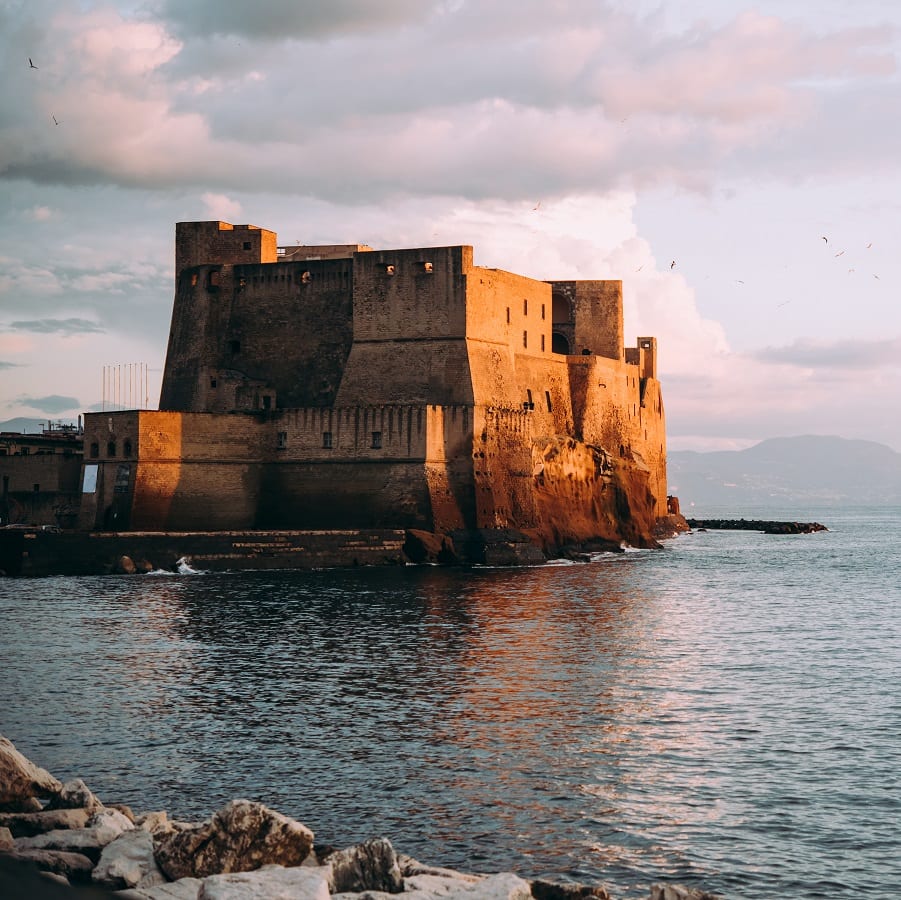
Day 1
Arrive Naples
Day 1
Arrive Naples



To Be Determined
Arrival in Naples Airport and Transfer by Taxi
Naples has one main airport, Naples Capodichino International Airport. Official taxis are available directly at the terminal exit, or you can arrange a private transfer for added convenience. Official Naples taxis are white, with registration numbers on the front doors and a taxi sign on the roof. Uber is not available in Naples.

Day 1
Arrive Naples


Day 1
Arrive Naples




To Be Determined:
Airport Transfer by Taxi
Mid-Day/Afternoon:
Naples Waterfront
Late Afternoon/Early Evening:
Naples Old Town


Day 2
Naples
Day 2
Naples


9:00 AM - 12:00 PM
Discover Naples On Foot Guided Walking Tour
Discover both the ancient and modern history of Naples as well as the real town: its people, the students, the food (the best pizzerias and pastry shops in Italy), and the craftsmanship on this three-hour private guided walking tour. Your personal guide will pick you up directly from your hotel.

Day 2
Naples


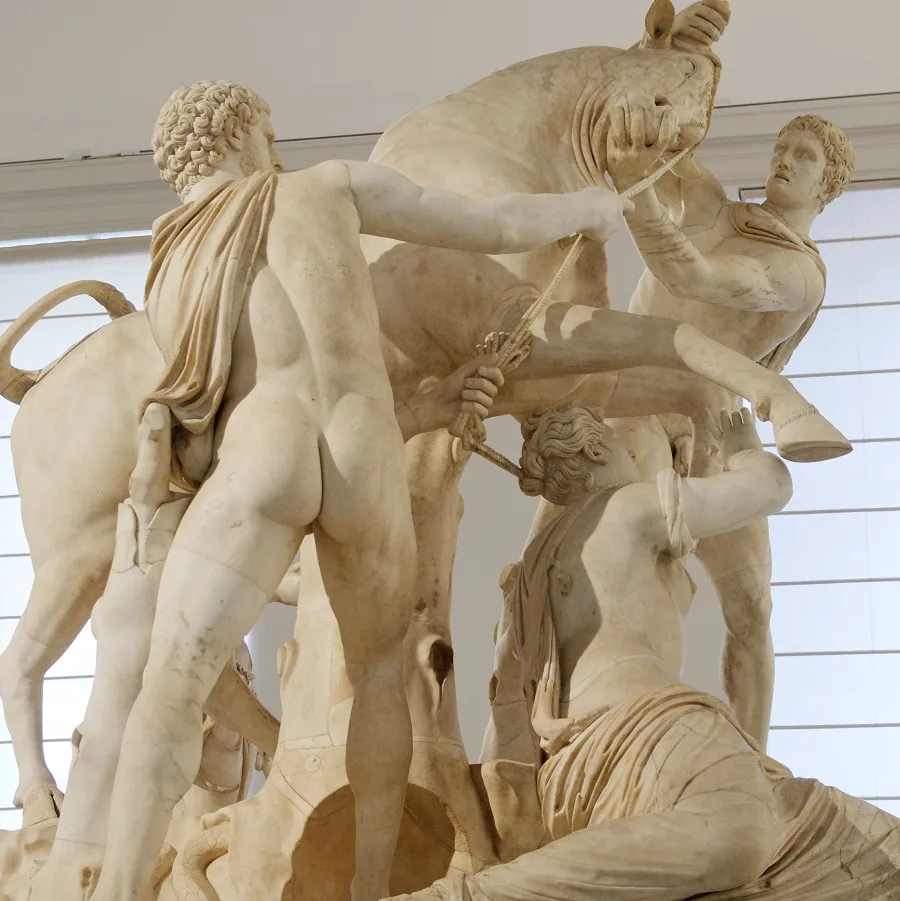
Day 3
Naples
Day 3
Naples




Morning/Mid-Day
National Archaeological Museum
The greatest Italian archaeological museum outside Rome, the Neopolitan National Archaeological Museum is a mandatory stop for anyone planning to visit Pompeii and Herculaneum, boasting as it does the greatest treasures from those two fateful townships. It also contains some of the most jaw-dropping sculptures from antiquity, including the fabulous Farnese Bull and the muscle-bound Ercole (Hercules) that once graced the Baths of Caracalla in Rome.

Day 3
Naples


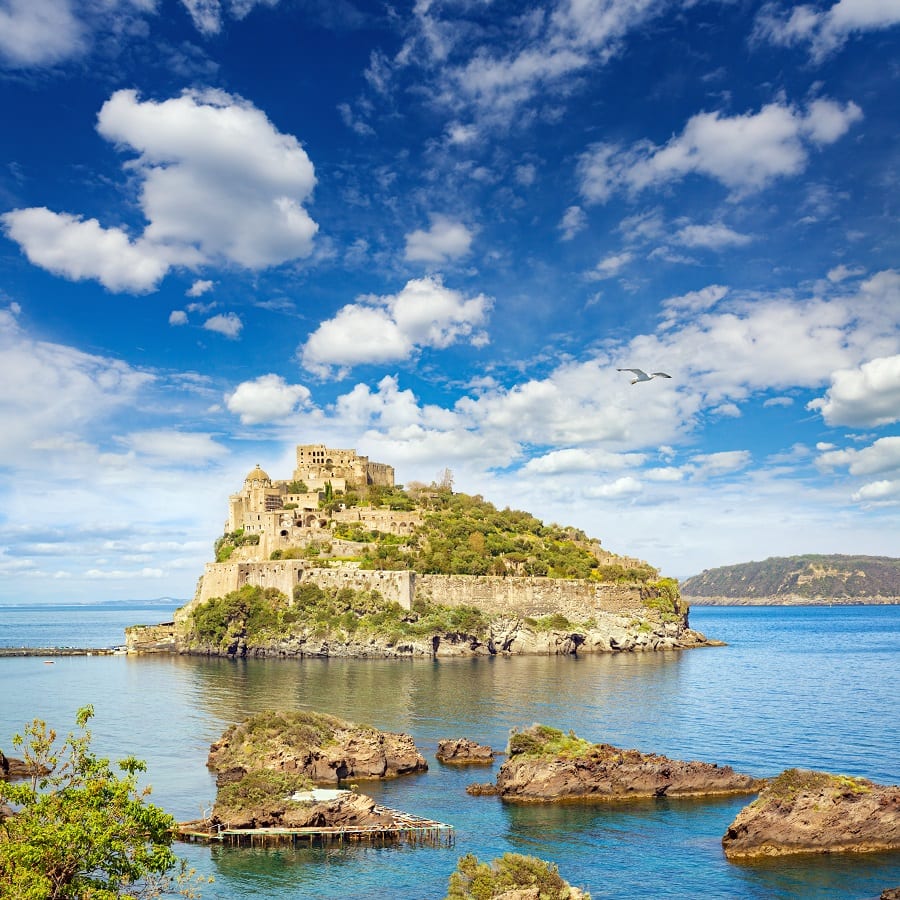
Day 4
Naples
Day 4
Naples


Early Morning to Mid-Day
Excursion to the Island of Ischia
The largest island in the Bay of Naples, Ischia is more interesting geographically than Capri, which makes it great for gentle hikes, especially to its summit of Mt Epomeo, and its volcanic soils make for the cultivation of fine wines. It also has some lovely sun-bathing spots and an exquisitely picturesque coastal fortress.

Castello Aragonese
Walk across a causeway to reach this picturesque medieval castle located on a small
Show More

Mt Epomeo
Hike to the top of Mount Epomeo for breathtaking views over the island.
Show More

Castello Aragonese
Walk across a causeway to reach this picturesque medieval castle located on a small
Show More

Mt Epomeo
Hike to the top of Mount Epomeo for breathtaking views over the island.
Show More

Castello Aragonese
Walk across a causeway to reach this picturesque medieval castle located on a small
Show More

Mt Epomeo
Hike to the top of Mount Epomeo for breathtaking views over the island.
Show More
prev
next

Day 4
Naples


Castello Aragonese
 Highlight of Ischia Island
Highlight of Ischia IslandWalk across a causeway to reach this picturesque medieval castle located on a small
Accessed via the 15th century Ponte Aragonese, a 750 feet (228m) long causeway, the rocky islet fortress of Alfonso the Magnanimous is Ischia's top sight. As you explore you will understand why it made such a stunning backdrop in the film The Talented Mr Ripley. The citadel itself is showing signs of wear and tear and some of it is closed to the public, but below is a complex of buildings that could be almost a separate village, and you can wander around these by way of olive-shaded paths and lush terraces. There's an eerie open shell of a cathedral destroyed by British bombardment in 1806 and a prison that once held political prisoners during the Unification struggle. Otherwise, there are a couple nice cafe-restaurants from where you can enjoy the sea views.There's also the remains of a convent, in which a couple of dark rooms are ringed with a set of seats that look like stone toilets. These actually served as a cemetery for the deceased sisters - the bodies were placed on these seats to decompose, and the nuns would gather to pray here. While today this all seems rather macabre, the sisters considered it a reminder of their own ephemeral existence on earth.

Mt Epomeo
 Highlight of Ischia Island
Highlight of Ischia IslandHike to the top of Mount Epomeo for breathtaking views over the island.
Take a short but steep hike up to Ischia's highest point on Mount Epomeo to enjoy superb views of the entire island of Ischia and its many vineyards. On a clear day, you can even see Mount Vesuvius, Sorrento and the island of Capri in the distance. You need to be reasonably fit and wear good shoes, as the final part of the track becomes no more than a channel cut out of the soft rock. There's a rather good terrace cafe/restaurant at the top where you can take a refreshment break.

Castello Aragonese
 Highlight of Ischia Island
Highlight of Ischia IslandWalk across a causeway to reach this picturesque medieval castle located on a small
Accessed via the 15th century Ponte Aragonese, a 750 feet (228m) long causeway, the rocky islet fortress of Alfonso the Magnanimous is Ischia's top sight. As you explore you will understand why it made such a stunning backdrop in the film The Talented Mr Ripley. The citadel itself is showing signs of wear and tear and some of it is closed to the public, but below is a complex of buildings that could be almost a separate village, and you can wander around these by way of olive-shaded paths and lush terraces. There's an eerie open shell of a cathedral destroyed by British bombardment in 1806 and a prison that once held political prisoners during the Unification struggle. Otherwise, there are a couple nice cafe-restaurants from where you can enjoy the sea views.There's also the remains of a convent, in which a couple of dark rooms are ringed with a set of seats that look like stone toilets. These actually served as a cemetery for the deceased sisters - the bodies were placed on these seats to decompose, and the nuns would gather to pray here. While today this all seems rather macabre, the sisters considered it a reminder of their own ephemeral existence on earth.

Mt Epomeo
 Highlight of Ischia Island
Highlight of Ischia IslandHike to the top of Mount Epomeo for breathtaking views over the island.
Take a short but steep hike up to Ischia's highest point on Mount Epomeo to enjoy superb views of the entire island of Ischia and its many vineyards. On a clear day, you can even see Mount Vesuvius, Sorrento and the island of Capri in the distance. You need to be reasonably fit and wear good shoes, as the final part of the track becomes no more than a channel cut out of the soft rock. There's a rather good terrace cafe/restaurant at the top where you can take a refreshment break.

Castello Aragonese
 Highlight of Ischia Island
Highlight of Ischia IslandWalk across a causeway to reach this picturesque medieval castle located on a small
Accessed via the 15th century Ponte Aragonese, a 750 feet (228m) long causeway, the rocky islet fortress of Alfonso the Magnanimous is Ischia's top sight. As you explore you will understand why it made such a stunning backdrop in the film The Talented Mr Ripley. The citadel itself is showing signs of wear and tear and some of it is closed to the public, but below is a complex of buildings that could be almost a separate village, and you can wander around these by way of olive-shaded paths and lush terraces. There's an eerie open shell of a cathedral destroyed by British bombardment in 1806 and a prison that once held political prisoners during the Unification struggle. Otherwise, there are a couple nice cafe-restaurants from where you can enjoy the sea views.There's also the remains of a convent, in which a couple of dark rooms are ringed with a set of seats that look like stone toilets. These actually served as a cemetery for the deceased sisters - the bodies were placed on these seats to decompose, and the nuns would gather to pray here. While today this all seems rather macabre, the sisters considered it a reminder of their own ephemeral existence on earth.

Mt Epomeo
 Highlight of Ischia Island
Highlight of Ischia IslandHike to the top of Mount Epomeo for breathtaking views over the island.
Take a short but steep hike up to Ischia's highest point on Mount Epomeo to enjoy superb views of the entire island of Ischia and its many vineyards. On a clear day, you can even see Mount Vesuvius, Sorrento and the island of Capri in the distance. You need to be reasonably fit and wear good shoes, as the final part of the track becomes no more than a channel cut out of the soft rock. There's a rather good terrace cafe/restaurant at the top where you can take a refreshment break.
prev
next


Day 5
Naples to Sorrento
Day 5
Naples to Sorrento






Morning/Mid-Day
Take a Trip up to the Capodimonte
Walk or catch a bus up the Capodimonte Hill to visit the fascinating early Christian catacombs beneath the churches of San Gennaro or Santa Maria della Sanità. Alternatively, continue further up the hill to visit the former residence of Bourbon King Charles III, Palazzo Reale di Capodimonte, to see one of the country's best art collections with works by Michelangelo, Titian, and Caravaggio.

Catacombs of San Gennaro
Take a guided tour and descend into the catacombs to see an ancient Christian burial place.
Show More

Capodimonte Park
Take a relaxing stroll in the oldest and most beautiful public park in the city.
Show More

Museo Nazionale di Capodimonte
Spend some quality time with Caravaggio and Titian in one of Italy's largest and best art collections.
Show More

Catacombs of San Gennaro
Take a guided tour and descend into the catacombs to see an ancient Christian burial place.
Show More

Capodimonte Park
Take a relaxing stroll in the oldest and most beautiful public park in the city.
Show More

Museo Nazionale di Capodimonte
Spend some quality time with Caravaggio and Titian in one of Italy's largest and best art collections.
Show More

Catacombs of San Gennaro
Take a guided tour and descend into the catacombs to see an ancient Christian burial place.
Show More
prev
next

Day 5
Naples to Sorrento


Catacombs of San Gennaro
 Highlight of Capodimonte
Highlight of CapodimonteTake a guided tour and descend into the catacombs to see an ancient Christian burial place.
The catacombs date from the second century AD and seem to have developed around the family tomb of an early member of the Christian community. It probably became the official cemetery of Christian Naples after the burial here, in the 3rd century, of the bishop-saint Agrippinus, over whose tomb a basilica was built. The catacombs became a place of pilgrimage after the 5th-century martyr and patron saint of the city, San Gennaro, was entombed here. Some of the early Christian frescoes and mosaics have been newly restored, and much of the complex has been superbly lit, which provides visitors not only with an ideal view of the rows of tombs, but also a wonderful ambiance. Temperatures range between 17-22 degrees Celsius throughout the year, so take warm clothing if you think you might be shivering throughout the 45min tours.

Capodimonte Park
 Highlight of Capodimonte
Highlight of CapodimonteTake a relaxing stroll in the oldest and most beautiful public park in the city.
With exquisite views of the city and Bay of Naples, this enormous landscaped park is a great opportunity to exchange the urban chaos of Naples for some greenery. The park covers nearly 100 acres and over the last nearly 300 years it has been filled with over 400 different plant species.
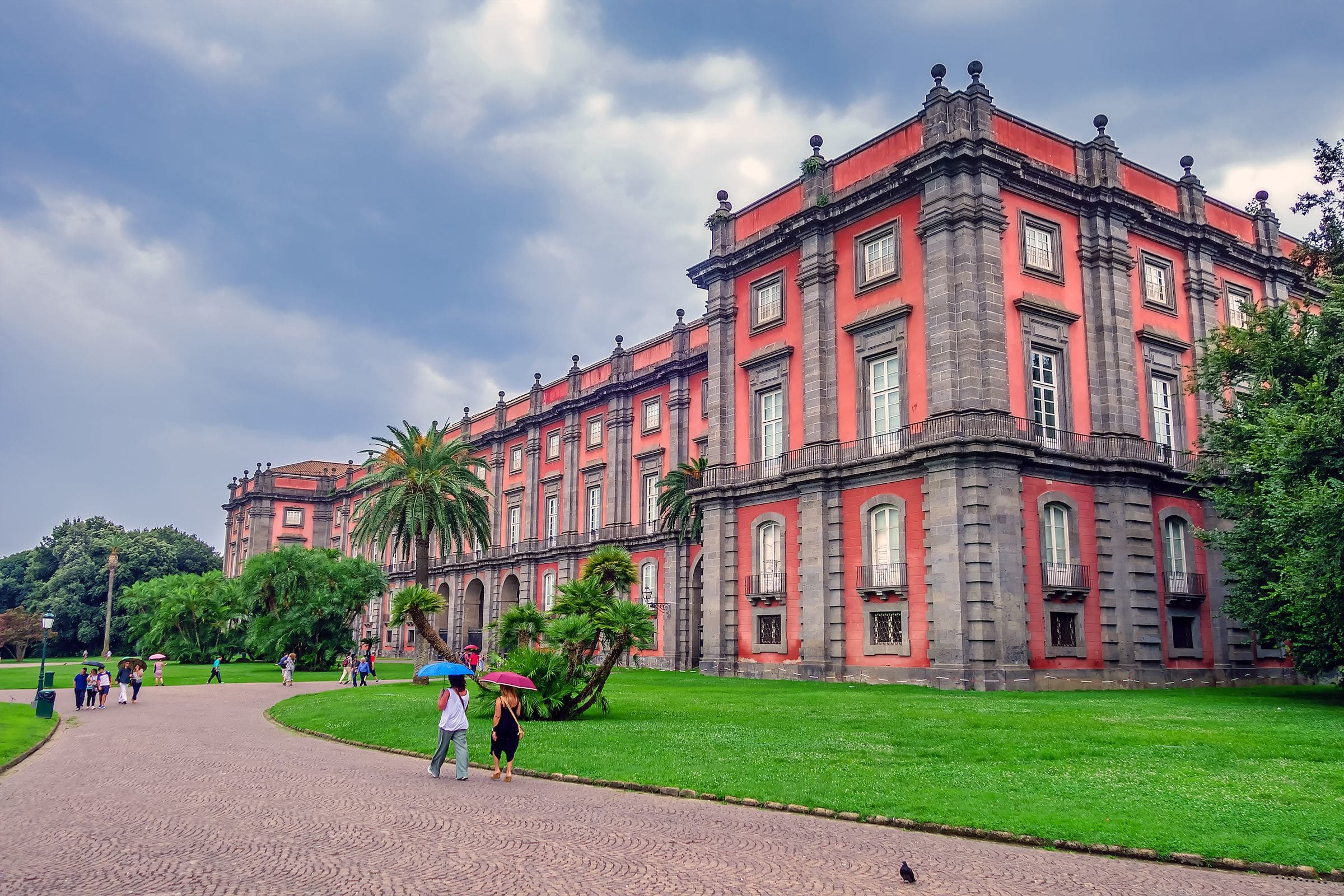
Museo Nazionale di Capodimonte
 Highlight of Capodimonte
Highlight of CapodimonteSpend some quality time with Caravaggio and Titian in one of Italy's largest and best art collections.
The Palazzo Reale di Capodimonte was the royal residence of the Bourbon King Charles III. Purpose-built in 1738 by Charles specifically to house the family art collection, it now operates as one of the best public art galleries in the country, the Museo Nazionale di Capodimonte. A large part of the first floor is dedicated to the fabulous Farnese Collections. Among the great paintings to look out for here are Sandro Bollicelli's Madonna and Child with Two Angels, and the Venetian painter Giovanni Bellini's masterpiece Transfiguration. Another great Venetian painter, Titian, is represented here by his depiction of Danaë. The second floor focuses on the development of painting in Naples 1200-1700, and while there are a number of masterpieces here, the two standouts are Flagellation by Caravaggio, and Judith and Holofernes by Artemisia Gentileschi. The first is a dark and disturbing painting that comes from the church of San Domenico Maggiore, where you can still see a 17th-century copy. Caravaggio was known to work in a darkened studio using point-source lighting to increase the contrast, hence the dramatic effect of his images.

Catacombs of San Gennaro
 Highlight of Capodimonte
Highlight of CapodimonteTake a guided tour and descend into the catacombs to see an ancient Christian burial place.
The catacombs date from the second century AD and seem to have developed around the family tomb of an early member of the Christian community. It probably became the official cemetery of Christian Naples after the burial here, in the 3rd century, of the bishop-saint Agrippinus, over whose tomb a basilica was built. The catacombs became a place of pilgrimage after the 5th-century martyr and patron saint of the city, San Gennaro, was entombed here. Some of the early Christian frescoes and mosaics have been newly restored, and much of the complex has been superbly lit, which provides visitors not only with an ideal view of the rows of tombs, but also a wonderful ambiance. Temperatures range between 17-22 degrees Celsius throughout the year, so take warm clothing if you think you might be shivering throughout the 45min tours.

Capodimonte Park
 Highlight of Capodimonte
Highlight of CapodimonteTake a relaxing stroll in the oldest and most beautiful public park in the city.
With exquisite views of the city and Bay of Naples, this enormous landscaped park is a great opportunity to exchange the urban chaos of Naples for some greenery. The park covers nearly 100 acres and over the last nearly 300 years it has been filled with over 400 different plant species.

Museo Nazionale di Capodimonte
 Highlight of Capodimonte
Highlight of CapodimonteSpend some quality time with Caravaggio and Titian in one of Italy's largest and best art collections.
The Palazzo Reale di Capodimonte was the royal residence of the Bourbon King Charles III. Purpose-built in 1738 by Charles specifically to house the family art collection, it now operates as one of the best public art galleries in the country, the Museo Nazionale di Capodimonte. A large part of the first floor is dedicated to the fabulous Farnese Collections. Among the great paintings to look out for here are Sandro Bollicelli's Madonna and Child with Two Angels, and the Venetian painter Giovanni Bellini's masterpiece Transfiguration. Another great Venetian painter, Titian, is represented here by his depiction of Danaë. The second floor focuses on the development of painting in Naples 1200-1700, and while there are a number of masterpieces here, the two standouts are Flagellation by Caravaggio, and Judith and Holofernes by Artemisia Gentileschi. The first is a dark and disturbing painting that comes from the church of San Domenico Maggiore, where you can still see a 17th-century copy. Caravaggio was known to work in a darkened studio using point-source lighting to increase the contrast, hence the dramatic effect of his images.

Catacombs of San Gennaro
 Highlight of Capodimonte
Highlight of CapodimonteTake a guided tour and descend into the catacombs to see an ancient Christian burial place.
The catacombs date from the second century AD and seem to have developed around the family tomb of an early member of the Christian community. It probably became the official cemetery of Christian Naples after the burial here, in the 3rd century, of the bishop-saint Agrippinus, over whose tomb a basilica was built. The catacombs became a place of pilgrimage after the 5th-century martyr and patron saint of the city, San Gennaro, was entombed here. Some of the early Christian frescoes and mosaics have been newly restored, and much of the complex has been superbly lit, which provides visitors not only with an ideal view of the rows of tombs, but also a wonderful ambiance. Temperatures range between 17-22 degrees Celsius throughout the year, so take warm clothing if you think you might be shivering throughout the 45min tours.
prev
next


Day 6
Sorrento
Day 6
Sorrento

Morning to Late Afternoon
Excursion to the Fabled Isle of Capri
There is no question that Capri is one of the most impressive spots in Italy. Surrounded by crystal clear waters, shimmering grottos and dramatic cliff-faces, it’s what dreams are made of. Made famous as the vacation hideaway of Roman emperors Augustus and Tiberius, the beautiful island of Capri is a fantastic day trip option from Sorrento by ferry. Spend your day exploring its two towns, Capri & Anacapri, take a boat trip to Capri's famous Blue Grotto or take a thrilling ride on the chairlift to Monte Solaro for beautiful views over Capri and the Bay of Naples.

Villa San Michele
Visit the beautiful residence of the Swedish physician and writer Alex Munthe, one of the top sights on the island.
Show More

Anacapri
Take a taxi or bus up to this pretty little village awash with boutique shops and high priced restaurants.
Show More

Blue Grotto
Take a boat trip around the island to reach this mystical Blue grotto cave.
Show More

Mount Solaro Chairlift
Take the chairlift up to Mount Solaro for amazing views over Capri and the Bay of Naples.
Show More

Villa San Michele
Visit the beautiful residence of the Swedish physician and writer Alex Munthe, one of the top sights on the island.
Show More

Anacapri
Take a taxi or bus up to this pretty little village awash with boutique shops and high priced restaurants.
Show More

Blue Grotto
Take a boat trip around the island to reach this mystical Blue grotto cave.
Show More

Mount Solaro Chairlift
Take the chairlift up to Mount Solaro for amazing views over Capri and the Bay of Naples.
Show More
prev
next

Day 6
Sorrento

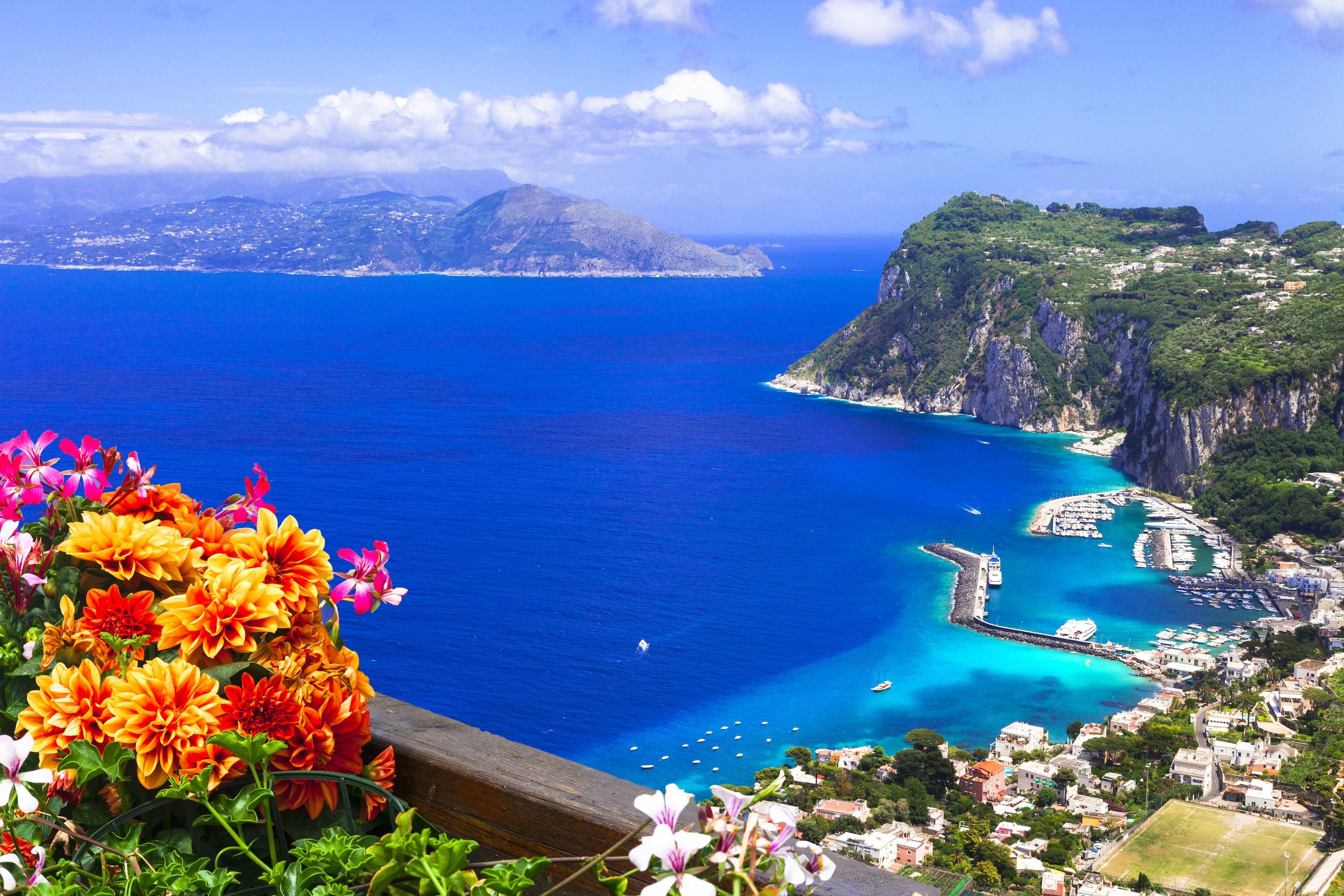
Villa San Michele
 Highlight of Capri Island
Highlight of Capri IslandVisit the beautiful residence of the Swedish physician and writer Alex Munthe, one of the top sights on the island.
This beautiful 20th-century mansion is one of the top sights on the island. Sitting almost 1000 feet above the sea, visitors come to the villa to walk through its beautiful gardens and enjoy the panoramic views of the town of Capri. Inside the villa, you'll find a small museum home to a collection of archaeological artefacts found on the island.

Anacapri
 Highlight of Capri Island
Highlight of Capri IslandTake a taxi or bus up to this pretty little village awash with boutique shops and high priced restaurants.
High up the plateau above Capri town lies Anacapri, a smaller village (compared to Capri Town) which is much quieter and more authentic in feel. Stroll its white-washed lanes of artisan boutiques, take the chairlift to the top of Monte Solaro or walk to the nearby Villa San Michele.
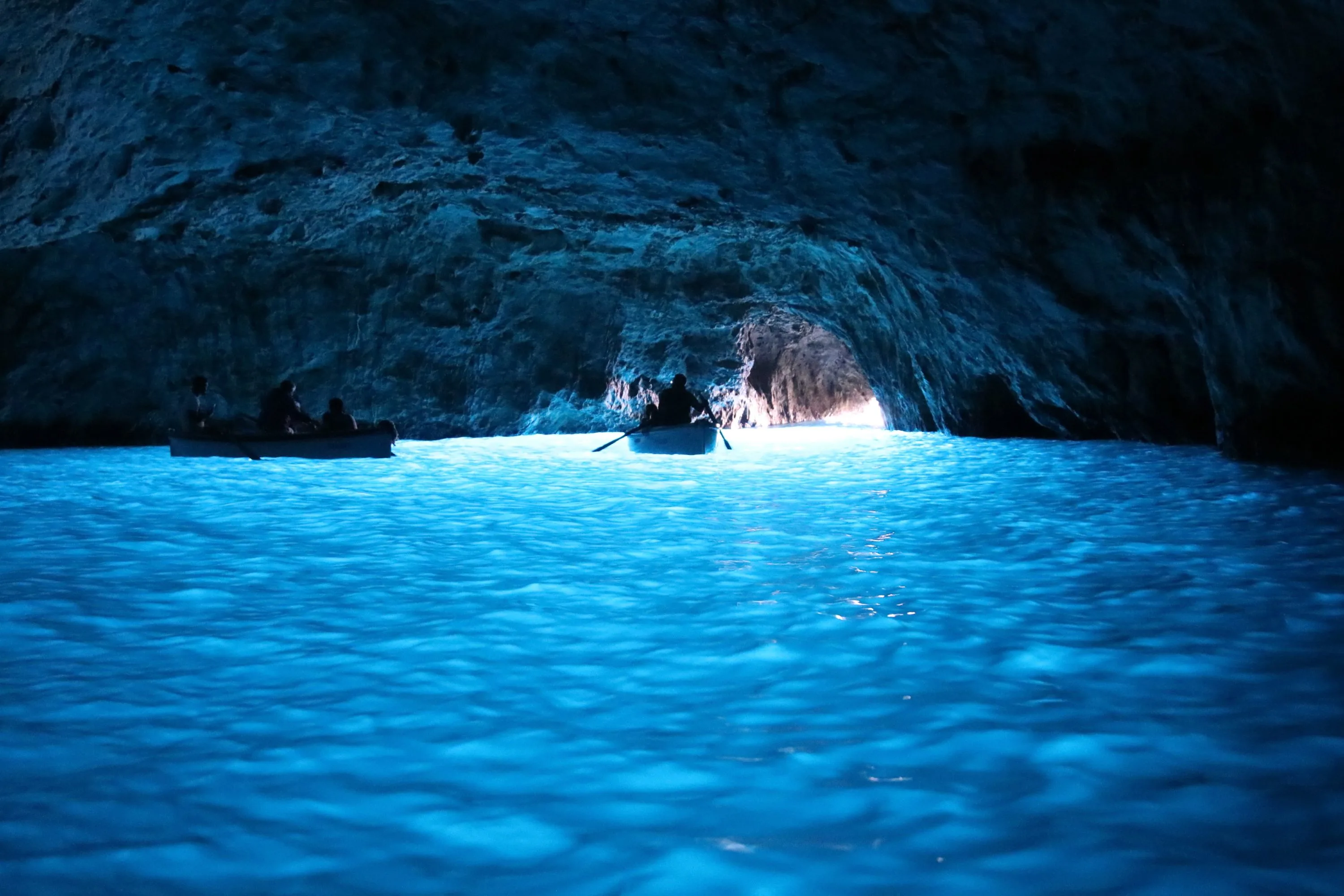
Blue Grotto
 Highlight of Capri Island
Highlight of Capri IslandTake a boat trip around the island to reach this mystical Blue grotto cave.
Named the Grotto Azzurra in Italian (Blue Grotto), this famous sea cave is a popular trip from Capri by boat. Sunlight passing through the small entrance creates a bright blue water grotto which is only accessible by a small rowing boat. Lie down flat in the boat, pass through the entrance and awe at the aqua colours of this natural wonder.

Mount Solaro Chairlift
 Highlight of Capri Island
Highlight of Capri IslandTake the chairlift up to Mount Solaro for amazing views over Capri and the Bay of Naples.
Ride to the summit of Capri's mountain on a thrilling chairlift journey. The scenic ride up takes approximately 12 minutes, and from the top you'll enjoy views over Capri and over the Bay of Naples with Mount Vesuvius in the distance.

Villa San Michele
 Highlight of Capri Island
Highlight of Capri IslandVisit the beautiful residence of the Swedish physician and writer Alex Munthe, one of the top sights on the island.
This beautiful 20th-century mansion is one of the top sights on the island. Sitting almost 1000 feet above the sea, visitors come to the villa to walk through its beautiful gardens and enjoy the panoramic views of the town of Capri. Inside the villa, you'll find a small museum home to a collection of archaeological artefacts found on the island.

Anacapri
 Highlight of Capri Island
Highlight of Capri IslandTake a taxi or bus up to this pretty little village awash with boutique shops and high priced restaurants.
High up the plateau above Capri town lies Anacapri, a smaller village (compared to Capri Town) which is much quieter and more authentic in feel. Stroll its white-washed lanes of artisan boutiques, take the chairlift to the top of Monte Solaro or walk to the nearby Villa San Michele.

Blue Grotto
 Highlight of Capri Island
Highlight of Capri IslandTake a boat trip around the island to reach this mystical Blue grotto cave.
Named the Grotto Azzurra in Italian (Blue Grotto), this famous sea cave is a popular trip from Capri by boat. Sunlight passing through the small entrance creates a bright blue water grotto which is only accessible by a small rowing boat. Lie down flat in the boat, pass through the entrance and awe at the aqua colours of this natural wonder.

Mount Solaro Chairlift
 Highlight of Capri Island
Highlight of Capri IslandTake the chairlift up to Mount Solaro for amazing views over Capri and the Bay of Naples.
Ride to the summit of Capri's mountain on a thrilling chairlift journey. The scenic ride up takes approximately 12 minutes, and from the top you'll enjoy views over Capri and over the Bay of Naples with Mount Vesuvius in the distance.
prev
next

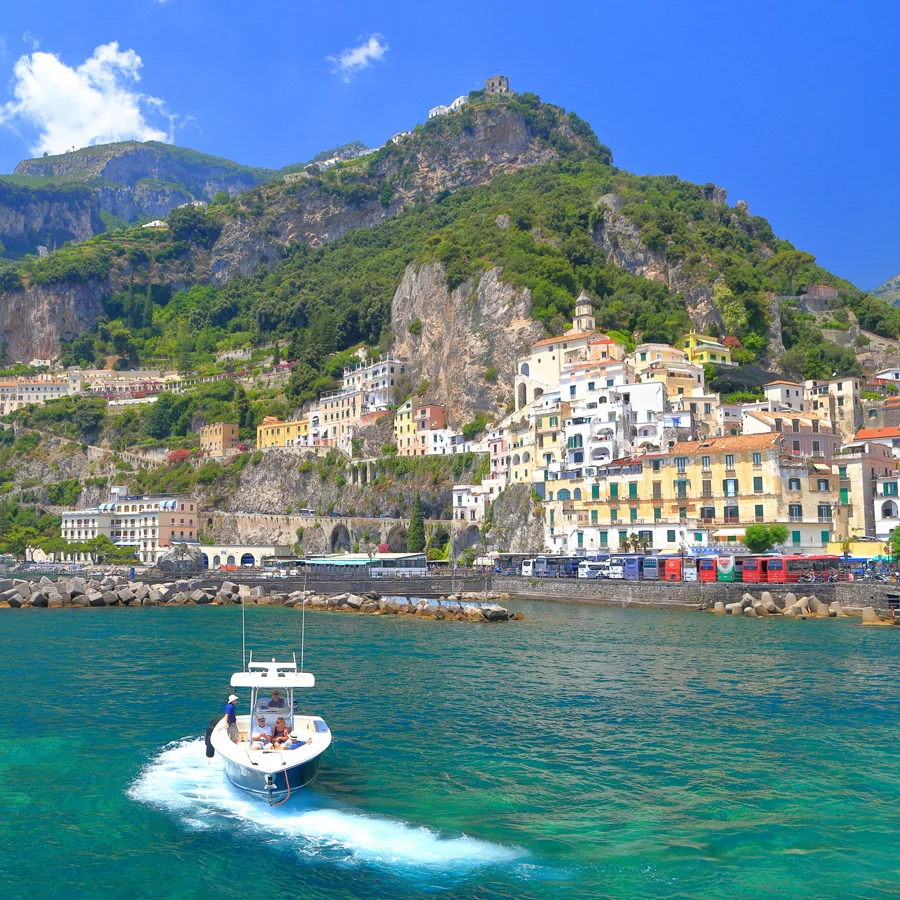
Day 7
Sorrento
Day 7
Sorrento

Morning to Early Evening
Exploring the Amalfi Coast
The wildly scenic Amalfi Coast that runs from Sorrento to Salerno is infamous for its coastal road which is known as one of the best white-knuckle scenic rides in Europe. Given the hairy driving, impossible parking and traffic, and overcrowded public buses, the Amalfi Coast is best explored by private boat or public ferry, where you can enjoy the scenic beauty of the coastline and hop from town to town in comfort and without any delays. Unfortunately, the boats do not run all year, so depending on when you travel, your best bet for exploring the area may be with a guided tour by vehicle. The guide's local knowledge can help you avoid some of the traffic and cover the most beautiful spots. Of course a private tour at your own pace, by boat or car, is the ideal option.

Positano
Visit the most beautiful and most popular town on the Amalfi Coast.
Show More

Amalfi Town
Visit the largest town on the Amalfi Coast known for its culture, history and beaches.
Show More

Amalfi Cathedral
Visit one of the most important Cathedrals on the Amalfi Coast.
Show More

Positano
Visit the most beautiful and most popular town on the Amalfi Coast.
Show More

Amalfi Town
Visit the largest town on the Amalfi Coast known for its culture, history and beaches.
Show More

Amalfi Cathedral
Visit one of the most important Cathedrals on the Amalfi Coast.
Show More

Positano
Visit the most beautiful and most popular town on the Amalfi Coast.
Show More
prev
next

Day 7
Sorrento

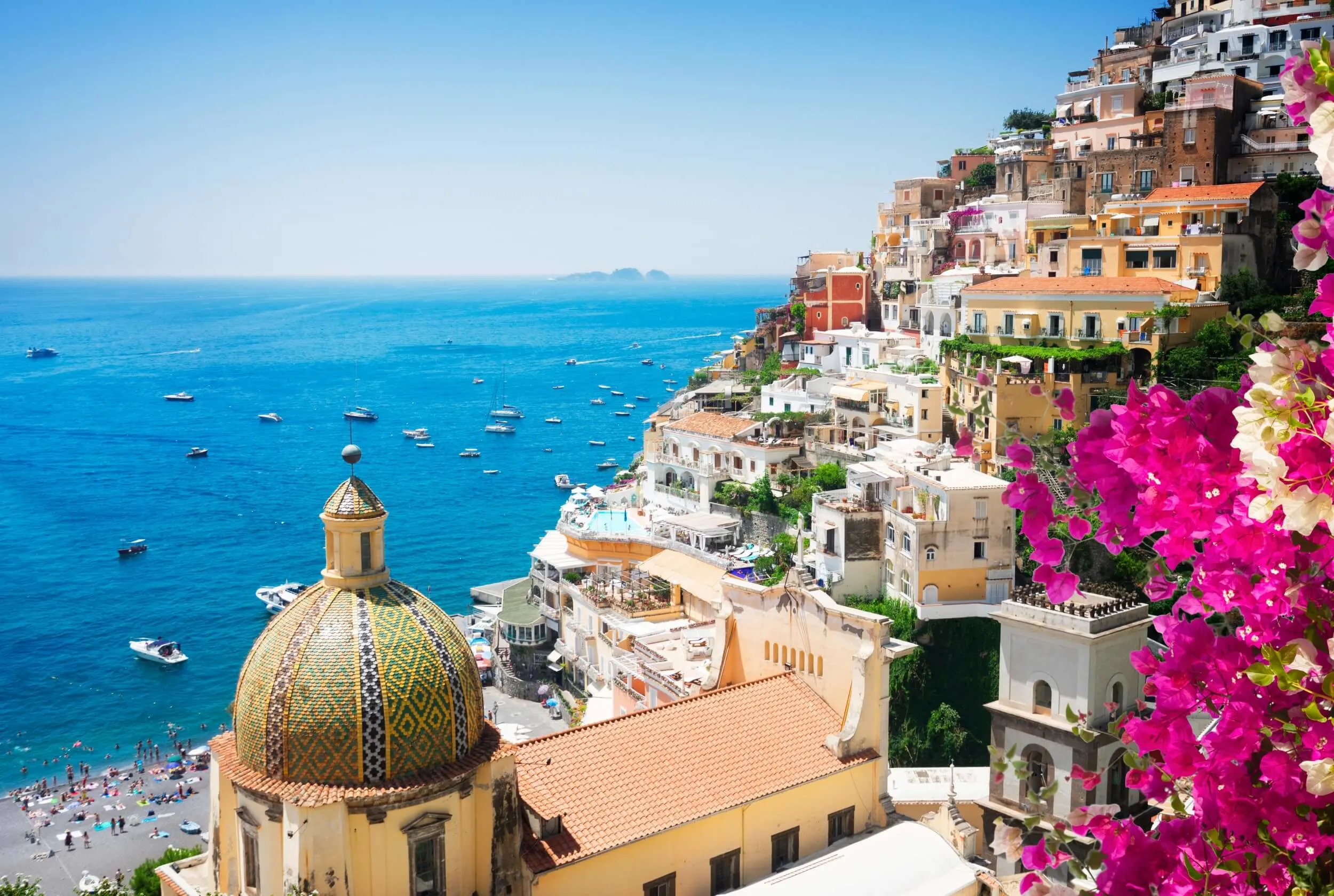
Positano
 Highlight of Amalfi Coast
Highlight of Amalfi CoastVisit the most beautiful and most popular town on the Amalfi Coast.
Known for its colorful buildings, beautiful panoramas, excellent seafood restaurants and luxury boutique shops, Positano is the go-to town for most people visiting the Amalfi Coast. Wander its narrow streets, spend time on its beach front or walk to the top of town to enjoy the famous views over the town and sea below.

Amalfi Town
 Highlight of Amalfi Coast
Highlight of Amalfi CoastVisit the largest town on the Amalfi Coast known for its culture, history and beaches.
What was once an important trading centre is now a stunning seaside town and the second most visited after Positano. Spend time relaxing on the beach and dip your toes in the azure water, visit its historic Cathedral, enjoy a cold lemon spritz in one of its seafront restaurants or simply enjoy strolling around its lanes and take in its views.
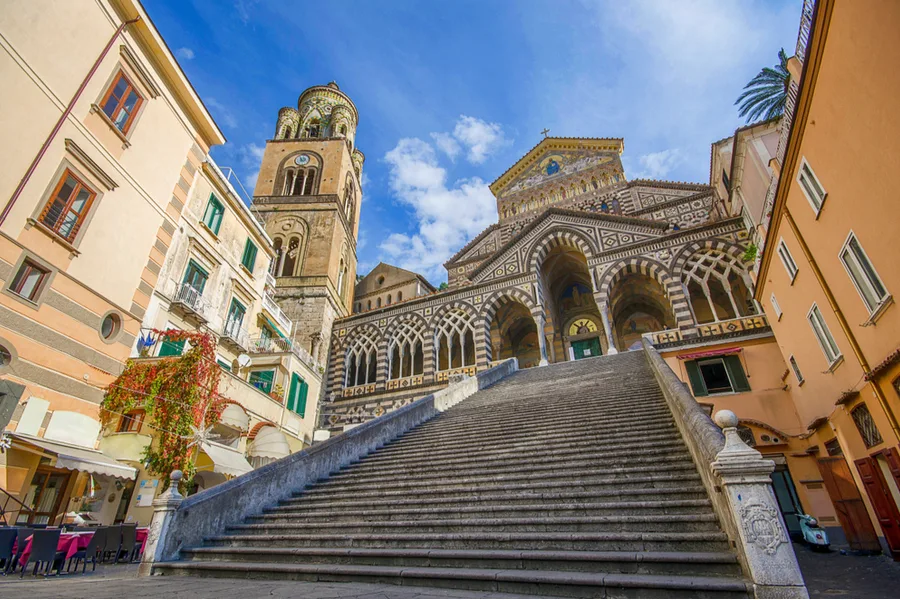
Amalfi Cathedral
 Highlight of Amalfi Coast
Highlight of Amalfi CoastVisit one of the most important Cathedrals on the Amalfi Coast.
The Amalfi Cathedral called “Duomo di Sant’Andrea Apostolo” can be found on the main Piazza Duomo in Amalfi Town. Built during the ninth century with a Byzantine architecture style, the cathedral is considered a must-visit for anyone who comes to Amalfi. Today the Duomo is a mix of Romanesque, Gothic and Baroque style, with an imposing staircase that leads to a 1,000-year-old bronze door that was given to the town by a wealthy local merchant who had the door made in Constantinople - modern-day Istanbul. Follow a one-way route around its interior which includes relics of Saint Andrew, the Apostle (the patron saint of Amalfi), the crypt and the cloister.

Positano
 Highlight of Amalfi Coast
Highlight of Amalfi CoastVisit the most beautiful and most popular town on the Amalfi Coast.
Known for its colorful buildings, beautiful panoramas, excellent seafood restaurants and luxury boutique shops, Positano is the go-to town for most people visiting the Amalfi Coast. Wander its narrow streets, spend time on its beach front or walk to the top of town to enjoy the famous views over the town and sea below.

Amalfi Town
 Highlight of Amalfi Coast
Highlight of Amalfi CoastVisit the largest town on the Amalfi Coast known for its culture, history and beaches.
What was once an important trading centre is now a stunning seaside town and the second most visited after Positano. Spend time relaxing on the beach and dip your toes in the azure water, visit its historic Cathedral, enjoy a cold lemon spritz in one of its seafront restaurants or simply enjoy strolling around its lanes and take in its views.

Amalfi Cathedral
 Highlight of Amalfi Coast
Highlight of Amalfi CoastVisit one of the most important Cathedrals on the Amalfi Coast.
The Amalfi Cathedral called “Duomo di Sant’Andrea Apostolo” can be found on the main Piazza Duomo in Amalfi Town. Built during the ninth century with a Byzantine architecture style, the cathedral is considered a must-visit for anyone who comes to Amalfi. Today the Duomo is a mix of Romanesque, Gothic and Baroque style, with an imposing staircase that leads to a 1,000-year-old bronze door that was given to the town by a wealthy local merchant who had the door made in Constantinople - modern-day Istanbul. Follow a one-way route around its interior which includes relics of Saint Andrew, the Apostle (the patron saint of Amalfi), the crypt and the cloister.

Positano
 Highlight of Amalfi Coast
Highlight of Amalfi CoastVisit the most beautiful and most popular town on the Amalfi Coast.
Known for its colorful buildings, beautiful panoramas, excellent seafood restaurants and luxury boutique shops, Positano is the go-to town for most people visiting the Amalfi Coast. Wander its narrow streets, spend time on its beach front or walk to the top of town to enjoy the famous views over the town and sea below.
prev
next


Day 8
Sorrento
Day 8
Sorrento

7:30 AM - 4:30 PM
Guided Hike of the Gods
Enjoy a 9-hour alpine guided climb up the ancient path that used to connect Nocelle (Positano) to Bomerano (Agerola) also known as the "Path of the Gods". Named after the beauties that characterize its views, this trail is considered one of the most beautiful hiking trails in the world.

Day 8
Sorrento


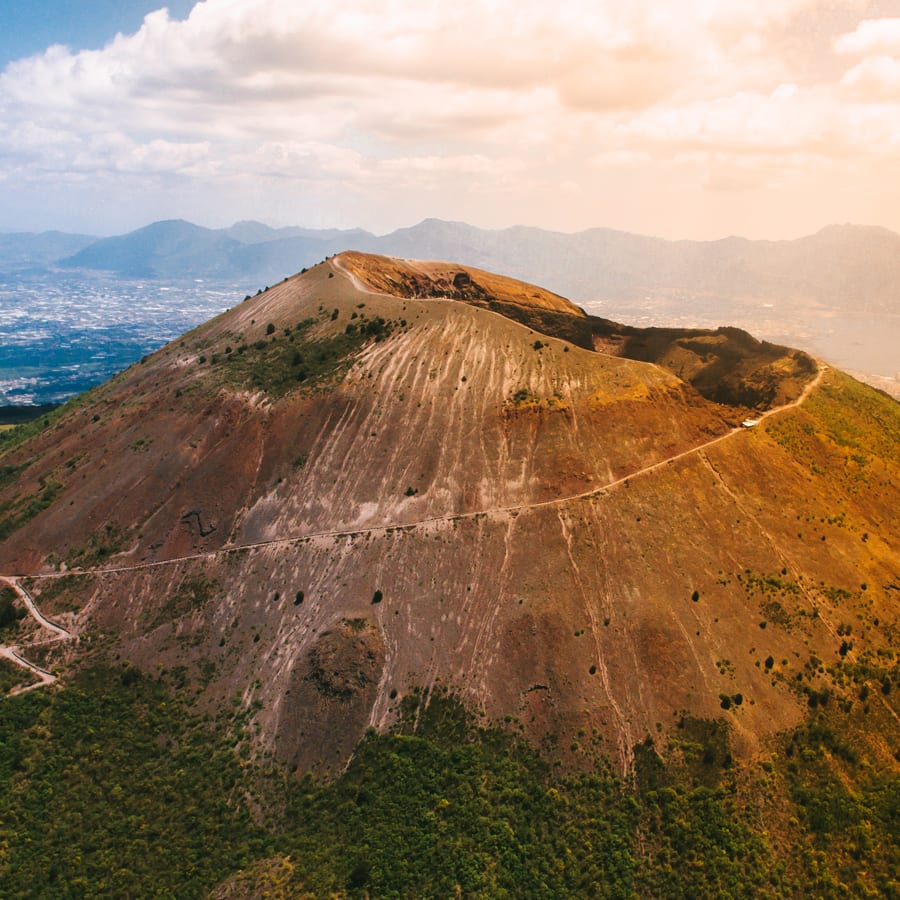
Day 9
Sorrento
Day 9
Sorrento


Early Morning to Mid-Day
Trip to Mount Vesuvius
Mount Vesuvius, the volcano renowned for the disaster that caused the destruction of Pompeii and Herculaneum, is a popular day trip from Naples and Sorrento. Rising up over the Bay of Naples, a visit to the active volcano offers an opportunity to get up close with its crater and witness the beautiful views over Naples and the surrounding area. The volcano and it's immediate surroundings are now a national park. You can take the train to the base, and then from the station catch a shuttle to the park entrance. If you prefer, you can also take a more comfortable tour directly to the park. Reasonably fit visitors should reach the summit within about 20 minutes (30-45 if you stop for photos). The trail is approximately half a mile in length and there are numerous points with benches where you can rest and enjoy the breathtaking view over Monte Somma and the Bay of Naples.

Day 9
Sorrento



Day 10
Depart Sorrento
Day 10
Depart Sorrento

To Be Determined
Private Transfer from Sorrento to Naples Airport
A private transfer service will pick you up from the N/A and take you directly to Naples Capodichino Airport. This is a private transfer for you and your travel party. You do not need to pay the driver as the cost of the transfer is included in your itinerary. IMPORTANT NOTE: Please be aware the car service can fit up to 1 checked item of luggage and 1 personal item per person, such as a purse or small backpack. If you think you will have more baggage, please inform your travel consultant as this may result in an additional fee.

Day 10
Depart Sorrento


What's Included In Your Trip

Pre-Paid Tours and Activities:
- Discover Naples On Foot Guided Walking Tour
- Guided Walking Tour of Herculaneum
- Guided Hike of the Gods
- Guided Tour of Herculaneum

Pre-Paid Transportation:
- 2nd Class Train Tickets from Naples-Sorrento
- Public Transport Tickets for Naples
- Private Transfer from Sorrento to Naples Airport

Accommodation:
- 5 nights at a hotel of your choice in Naples
- 6 nights at a hotel of your choice in Sorrento

Go Real Travel Mobile App:
- Itinerary Plan & Reservations Info
- Points of Interest
- Detailed Travel Information
- Maps & Directions
Other Trips You May Like

7 Days
From$1995USD

5 Days
From$1290USD

7 Days
From$2995USD

4 Days
From$897USD

7 Days
From$1859USD

11 Days
From$4300USD

9 Days
From$3790USD

10 Days
From$3870USD

9 Days
From$2356USD

7 Days
From$1995USD

5 Days
From$1290USD

7 Days
From$2995USD

4 Days
From$897USD

7 Days
From$1859USD

11 Days
From$4300USD

9 Days
From$3790USD

10 Days
From$3870USD

9 Days
From$2356USD
prev
next
Featured Blogs
prev
next
Our Customers Say It Best
Marianne Strydom, Paarl, South Africa
I just wanted to thank you for organizing an amazing trip for me – I packed in so much in such a short period of time and everything was just perfect. The way you do things makes it possible to really get to know the destination, which for me as a travel agent could not have been better. 

Otto Chuy, Los Angeles, California
I am still surprised how everything worked as planned, without a hitch. All instructions in your itinerary were precise and correct. Your suggestions and comments in each of the locations we went to were very helpful. All your guides, without exception, were wonderful and exactly on time. 

Malini Dutta, Boston, Massachusetts
We can't thank you enough for the detailed plans, maps, and suggestions. It really felt that someone was holding our hands and showing us around. We had all the excitement of discovering foreign lands, with none of the problems that can happen while negotiating unfamiliar places. In fact, all the cities felt like home within a few hours of arriving and exploring. 

Bev and Mark Frankel, Williamsburg, Virginia
We could not be more pleased with Go Real Travel! You took the guess work out of things like public transport but still managed to allow us the freedom to tour as we wanted. Our guides were exceptional and every time I saw a Viking Cruise tour of 25 people, I realized the quality experience we were getting with Go Real. 

Marianne Strydom, Paarl, South Africa
I just wanted to thank you for organizing an amazing trip for me – I packed in so much in such a short period of time and everything was just perfect. The way you do things makes it possible to really get to know the destination, which for me as a travel agent could not have been better. 

Otto Chuy, Los Angeles, California
I am still surprised how everything worked as planned, without a hitch. All instructions in your itinerary were precise and correct. Your suggestions and comments in each of the locations we went to were very helpful. All your guides, without exception, were wonderful and exactly on time. 

Malini Dutta, Boston, Massachusetts
We can't thank you enough for the detailed plans, maps, and suggestions. It really felt that someone was holding our hands and showing us around. We had all the excitement of discovering foreign lands, with none of the problems that can happen while negotiating unfamiliar places. In fact, all the cities felt like home within a few hours of arriving and exploring. 

Bev and Mark Frankel, Williamsburg, Virginia
We could not be more pleased with Go Real Travel! You took the guess work out of things like public transport but still managed to allow us the freedom to tour as we wanted. Our guides were exceptional and every time I saw a Viking Cruise tour of 25 people, I realized the quality experience we were getting with Go Real. 



Explore cities in more detail

Rome
One of the must-sees of Italy, and indeed all of Europe, Rome is a city with history flowing through its veins. There is an endless amount to see, do, and learn here, with something for every taste and disposition. Rome was the center of Western civilization for a Millenium and during that time, accumulated a list of historical and cultural treasures that no other destination can truly match. The Pantheon, Colosseum, Roman Forum, and Cirus of Maxentius are just a few examples of what can be seen and experienced in Rome, which at times feels more like a giant outdoor museum than a city. At Rome’s heart, you’ll find the Vatican, home of the Roman Catholic Church and the Pope. Here visitors can see the legendary Sistine Chapel. Transcending a mere building, the chapel is a walk-in work of art. Although historical sights can be found on just about every corner, it’s entirely possible to fill a day just wandering around Rome. The city’s charming streets and open Piazzas are filled with beautiful sights and places to sit, grab the best Cappuccino in the world, and enjoy the view.

Learn About Rome
Build Rome Trip

Florence
Culture and history are thick in the air in Florence. Located on the banks of the Arno River in Tuscany, Florence’s past is deeply compelling. The birthplace of the Renaissance, Florence is where innovators like Dante, Machiavelli, Michelangelo, and Da Vinci made their fortunes. Centuries of art, politics, and commerce have left their mark on every stone in this Northern Italian city. In the 15th and 16th centuries, Florentine banks funded new enterprises that went on to change the history of the world. Powerful families like the Medici’s financed some of the finest art in history and pioneered new ways of doing statecraft and politics. As you stand in the Piazzale Michelangelo and gaze upon the city below it’s hard to take it all in at once. It feels like behind every door in Florence might hide a work of genius. Michelangelo’s David and Botticelli’s Primavera can be found just a short walk away. After a long day wandering the streets and gazing at art, fueled by exquisite coffee and gelato, relax like the locals do: with a glass of some of the best wine in the world.

Learn About Florence
Build Florence Trip

Milan
Milan is Italy’s most forward-looking city. An international center for fashion, fine dining, and design, it seems as though Milanese people breathe style. From the gleam on your wine glass to the twists of its cathedral’s spires, everything in Milan is finished to perfection. Home to the Italian stock exchange, a world-famous fashion industry, and a frantic business district, Milan is fast-paced and commercially minded. The shopping in Milan is second to none. At the Galleria Vittorio Emanuele II, one of the world’s oldest shopping malls, a glass-iron ceiling soars over brands like Louis Vuitton, Gucci, Massimo Dutti, and Amani. Along with the fashion, Milan’s cathedral, castle, and canals are also must-sees. But to view the city’s most prized possession - Leonardo da Vinci’s Last Supper, you must make an appointment. Tickets to view this mural sell out weeks in advance. It is truly a bucket-list worthy work of art. After a day taking in all the glamor and culture, take a seat in one of Milan’s well-appointed eateries. The Navigli Quarter is packed with restaurants, bars, and cafes, perfect for a relaxed Aperol spritz or pizza along the city’s canals.

Learn About Milan
Build Milan Trip
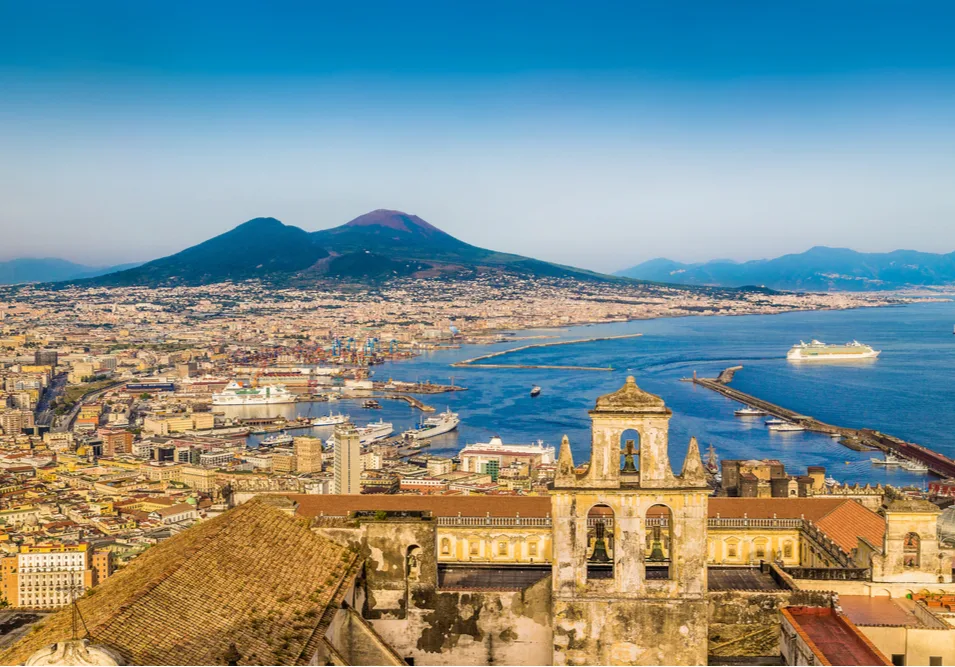
Naples
Gritty and chaotic Naples calls to travelers who want to experience the real Italy. Pressed along the coast of Campania, hilly Naples is jammed with maze-like streets, strung with outdoor clotheslines, descending toward the sea below. A much deserved UNESCO World Heritage site, Naples is famous for its churches, museums, castles, and catacombs. As you navigate the city, you’ll find yourself immersed by its culture and history. You can easily occupy a full day gazing at churches like the Naples Cathedral, San Francesco di Paola, and Cappella Sansevero. If you cast your eyes toward the Gulf of Naples, you’ll see Mount Vesuvius looming over the harbor. This foreboding volcano erupted in AD 79. Not far from the inner city — less than an hour by train — you’ll find the ancient town of Pompeii, its dramatic ruins still preserved in ash from the eruption. One of the best things you can do in Naples is to eat. This is the city where pizza was born. Propped up by its ripe tomatoes, local cheeses, and fresh fish, food from Naples has come to define what many see as the height of Italian cuisine. Everything you taste in Naples seems like a delicacy. Authentic and vivid, Naples is a true Italian city where the ancient world meets the modern-day with a bang.

Learn About Naples
Build Naples Trip
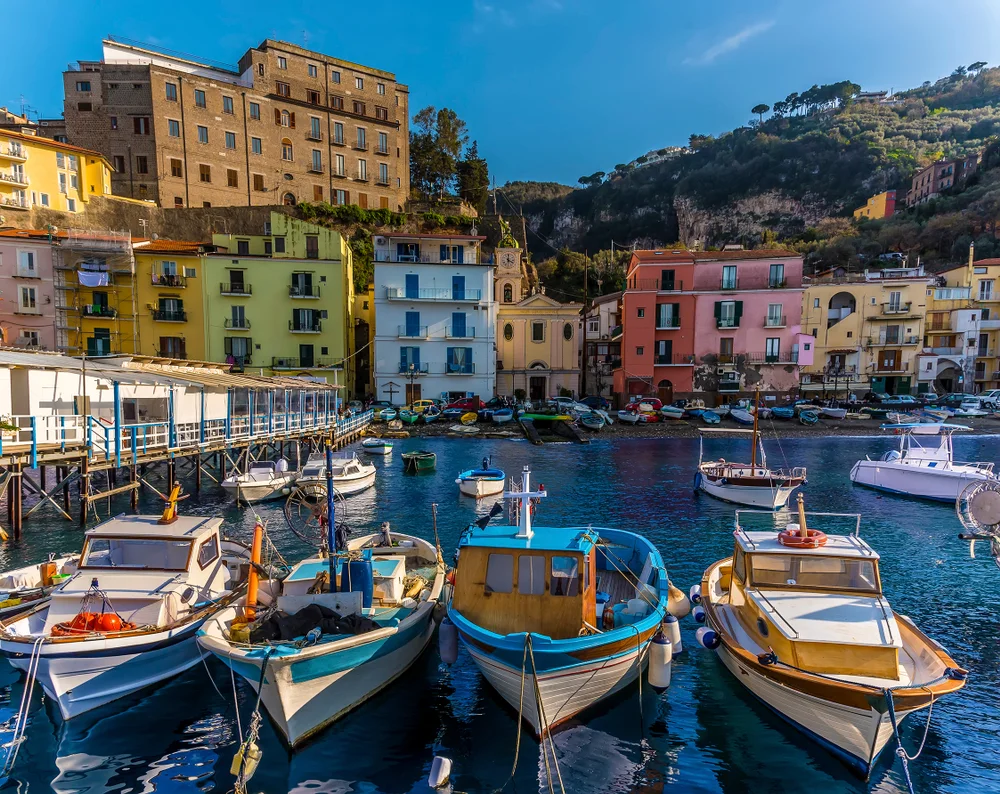
Sorrento
Sorrento is the perfect place to bask in the Mediterranean mood, somewhere to enjoy the sun, the sea, fine dining, and good wine. Churches like the Duomo and the Church del Carmine beg to be explored, along with museums, galleries, and castles. But mostly Sorrento is somewhere to kick back and, for a few days, focus entirely on the business of living - and living well. Seafood dinners, Limoncello evenings, swimming, hiking, and boat trips are all perfect ways to pass time in this seaside haven. If you really tire of all that, Sorrento is well-placed for those looking to explore its surrounding region. A train ride away from Naples, and within fairly easy reach of Pompeii, Sorrento is the doorstep to the attractions of Campania. A short ferry ride away is the island of Capri, with its own collection of beaches, restaurants, and excellent hiking. It’s not necessary, however, to pack the days full of exploring and adventure. While all that is certainly possible, a perfectly acceptable alternative is just to relax and soak in the special Mediterranean vibe.

Learn About Sorrento
Build Sorrento Trip
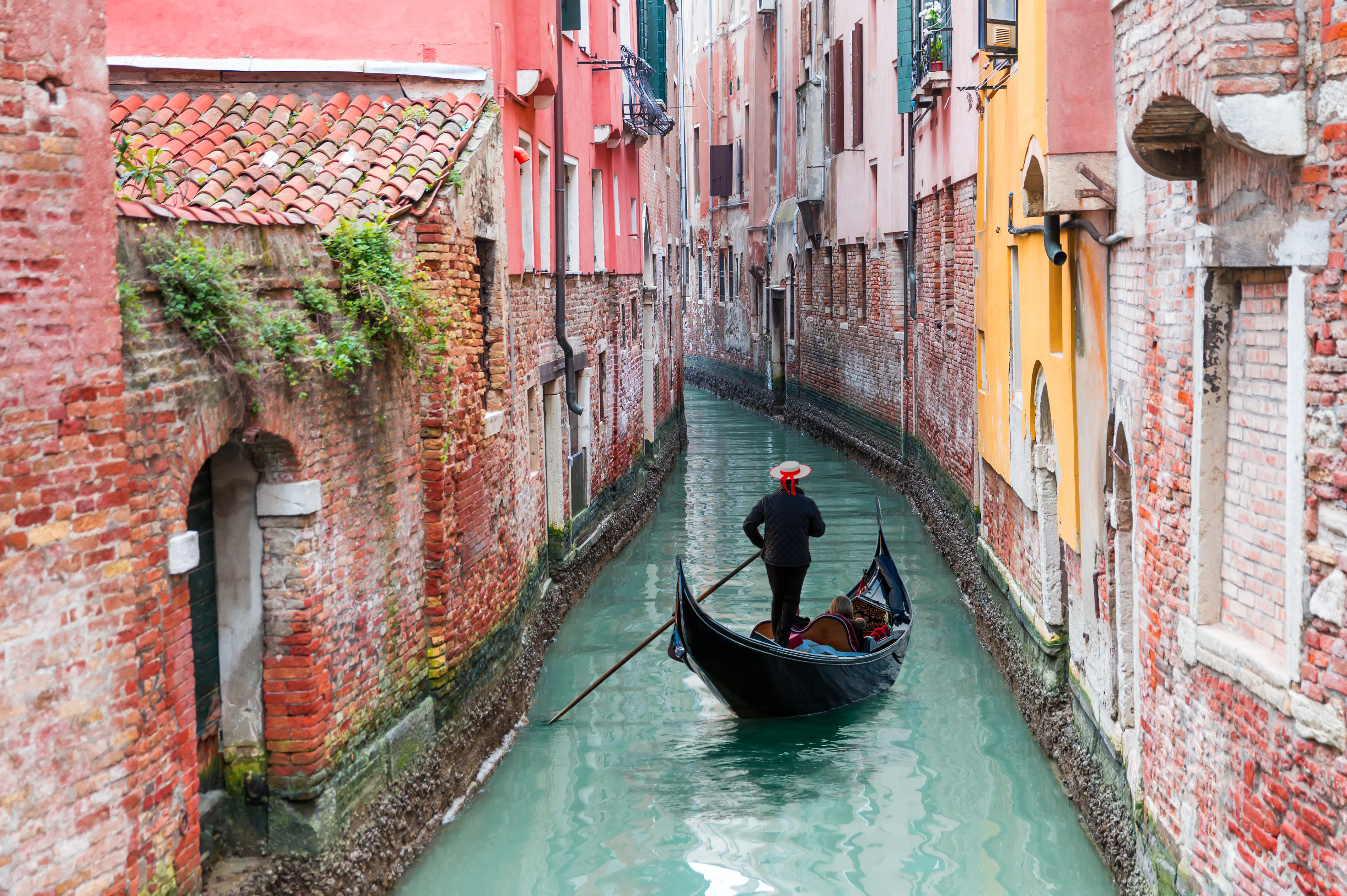
Venice
Venice is a city with no equal. Built on a series of islands on a lagoon, it was once a powerful city-state. Echoes of that old magnificence can be seen everywhere here, from the stunning buildings that rise out of the canals, to the bridges that arc across them. Take a Gondola ride through the canals that form the city’s veins, or wander through the winding streets drinking in the sights. You’ll see Venice attracts tourists in huge numbers, and that’s with good reason. It’s home to a seemingly limitless amount of art, culture, history, and architecture. St Mark’s Basilica, the Doge’s Palace, and the Campanile di San Marco just barely scratch the surface. There’s a 700-year-old market, Rialto, which is still open today. The Ponte di Rialto bridge connects the neighborhoods of San Marco and San Polo, stretching across the Grand Canal. Venice has weathered the last several centuries with elegance and pride, a place that will surpass even your highest expectations.

Learn About Venice
Build Venice Trip

Rome
One of the must-sees of Italy, and indeed all of Europe, Rome is a city with history flowing through its veins. There is an endless amount to see, do, and learn here, with something for every taste and disposition. Rome was the center of Western civilization for a Millenium and during that time, accumulated a list of historical and cultural treasures that no other destination can truly match. The Pantheon, Colosseum, Roman Forum, and Cirus of Maxentius are just a few examples of what can be seen and experienced in Rome, which at times feels more like a giant outdoor museum than a city. At Rome’s heart, you’ll find the Vatican, home of the Roman Catholic Church and the Pope. Here visitors can see the legendary Sistine Chapel. Transcending a mere building, the chapel is a walk-in work of art. Although historical sights can be found on just about every corner, it’s entirely possible to fill a day just wandering around Rome. The city’s charming streets and open Piazzas are filled with beautiful sights and places to sit, grab the best Cappuccino in the world, and enjoy the view.

Learn About Rome
Build Rome Trip

Florence
Culture and history are thick in the air in Florence. Located on the banks of the Arno River in Tuscany, Florence’s past is deeply compelling. The birthplace of the Renaissance, Florence is where innovators like Dante, Machiavelli, Michelangelo, and Da Vinci made their fortunes. Centuries of art, politics, and commerce have left their mark on every stone in this Northern Italian city. In the 15th and 16th centuries, Florentine banks funded new enterprises that went on to change the history of the world. Powerful families like the Medici’s financed some of the finest art in history and pioneered new ways of doing statecraft and politics. As you stand in the Piazzale Michelangelo and gaze upon the city below it’s hard to take it all in at once. It feels like behind every door in Florence might hide a work of genius. Michelangelo’s David and Botticelli’s Primavera can be found just a short walk away. After a long day wandering the streets and gazing at art, fueled by exquisite coffee and gelato, relax like the locals do: with a glass of some of the best wine in the world.

Learn About Florence
Build Florence Trip

Milan
Milan is Italy’s most forward-looking city. An international center for fashion, fine dining, and design, it seems as though Milanese people breathe style. From the gleam on your wine glass to the twists of its cathedral’s spires, everything in Milan is finished to perfection. Home to the Italian stock exchange, a world-famous fashion industry, and a frantic business district, Milan is fast-paced and commercially minded. The shopping in Milan is second to none. At the Galleria Vittorio Emanuele II, one of the world’s oldest shopping malls, a glass-iron ceiling soars over brands like Louis Vuitton, Gucci, Massimo Dutti, and Amani. Along with the fashion, Milan’s cathedral, castle, and canals are also must-sees. But to view the city’s most prized possession - Leonardo da Vinci’s Last Supper, you must make an appointment. Tickets to view this mural sell out weeks in advance. It is truly a bucket-list worthy work of art. After a day taking in all the glamor and culture, take a seat in one of Milan’s well-appointed eateries. The Navigli Quarter is packed with restaurants, bars, and cafes, perfect for a relaxed Aperol spritz or pizza along the city’s canals.

Learn About Milan
Build Milan Trip

Naples
Gritty and chaotic Naples calls to travelers who want to experience the real Italy. Pressed along the coast of Campania, hilly Naples is jammed with maze-like streets, strung with outdoor clotheslines, descending toward the sea below. A much deserved UNESCO World Heritage site, Naples is famous for its churches, museums, castles, and catacombs. As you navigate the city, you’ll find yourself immersed by its culture and history. You can easily occupy a full day gazing at churches like the Naples Cathedral, San Francesco di Paola, and Cappella Sansevero. If you cast your eyes toward the Gulf of Naples, you’ll see Mount Vesuvius looming over the harbor. This foreboding volcano erupted in AD 79. Not far from the inner city — less than an hour by train — you’ll find the ancient town of Pompeii, its dramatic ruins still preserved in ash from the eruption. One of the best things you can do in Naples is to eat. This is the city where pizza was born. Propped up by its ripe tomatoes, local cheeses, and fresh fish, food from Naples has come to define what many see as the height of Italian cuisine. Everything you taste in Naples seems like a delicacy. Authentic and vivid, Naples is a true Italian city where the ancient world meets the modern-day with a bang.

Learn About Naples
Build Naples Trip

Sorrento
Sorrento is the perfect place to bask in the Mediterranean mood, somewhere to enjoy the sun, the sea, fine dining, and good wine. Churches like the Duomo and the Church del Carmine beg to be explored, along with museums, galleries, and castles. But mostly Sorrento is somewhere to kick back and, for a few days, focus entirely on the business of living - and living well. Seafood dinners, Limoncello evenings, swimming, hiking, and boat trips are all perfect ways to pass time in this seaside haven. If you really tire of all that, Sorrento is well-placed for those looking to explore its surrounding region. A train ride away from Naples, and within fairly easy reach of Pompeii, Sorrento is the doorstep to the attractions of Campania. A short ferry ride away is the island of Capri, with its own collection of beaches, restaurants, and excellent hiking. It’s not necessary, however, to pack the days full of exploring and adventure. While all that is certainly possible, a perfectly acceptable alternative is just to relax and soak in the special Mediterranean vibe.

Learn About Sorrento
Build Sorrento Trip

Venice
Venice is a city with no equal. Built on a series of islands on a lagoon, it was once a powerful city-state. Echoes of that old magnificence can be seen everywhere here, from the stunning buildings that rise out of the canals, to the bridges that arc across them. Take a Gondola ride through the canals that form the city’s veins, or wander through the winding streets drinking in the sights. You’ll see Venice attracts tourists in huge numbers, and that’s with good reason. It’s home to a seemingly limitless amount of art, culture, history, and architecture. St Mark’s Basilica, the Doge’s Palace, and the Campanile di San Marco just barely scratch the surface. There’s a 700-year-old market, Rialto, which is still open today. The Ponte di Rialto bridge connects the neighborhoods of San Marco and San Polo, stretching across the Grand Canal. Venice has weathered the last several centuries with elegance and pride, a place that will surpass even your highest expectations.

Learn About Venice
Build Venice Trip
prev
next


 Map of Your Itinerary Route
Map of Your Itinerary Route
Zoom In to the cities to see your itinerary in more detail


 4.8
4.8 







